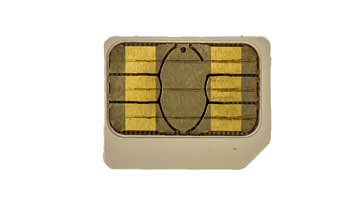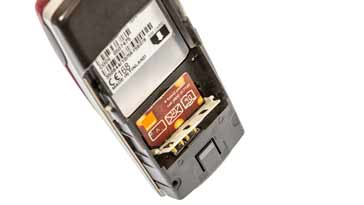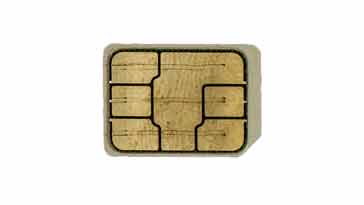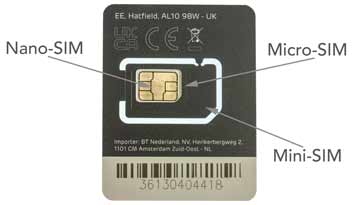What is a SIM Card
The SIM card or Subscriber Identification Module is a small printed circuit card installed in most mobile phones to store data including the subscriber identification etc
Cellular / Mobile Telecommunications Basics Includes:
What is cellular communications
Concept of cellular system
Radio access network, RAN
Basestation Technology
Base station antenna technology
Multiple access techniques
Duplex techniques
What's inside a cellphone
SIM cards
Handover
Backhaul
SIM cards are now an integral element of mobile phone operation. They are installed in virtually all mobile phones these days.
The SIM card or Subscriber Identity Module / Subscriber Identification Module is a small printed circuit card that incorporates a integrated circuit that is used to securely store data.

These cards can be transferred from one mobile to the next when a subscriber updates their phone and it retains the number and various other items of data, enabling them to be transferred easily from one phone to the next.
SIM card basics
The SIM card consists of a small integrated circuit located within a plastic carrier forming a type of printed circuit board. This has a number of gold plated contacts on it that are used to connect the functionality of the IC within the SIM card to the phone itself.
The SIM card can store a variety of data. This includes the ICCID or Integrated Circuit Card ID. This is an 18 to 22 digit number that is a globally unique number stored within the SIM that identifies the card itself.
All SIM cards that are designed for use in phones and tablets start with the number 89 – 89 is a code for a product that is designed to run on telecommunication networks.
The card also contains the IMSI, or international mobile subscriber identity number as well as authentication and ciphering information.
It also stores temporary information related to the local network, and a list of services to which the user has access. There are also two passwords: a personal identification number, PIN for ordinary use, and a personal unblocking key or PUK for PIN unlocking.
Further information that can be stored on the SIM includes information used within Europe: the serial SIM number or SSN and this is also sometimes accompanied by an international article number or IAN or a European article number EAN which is needed when registering online for the subscription of a prepaid card.
In addition to all of this the SIM card can also store contact information. Often mobile phones give the option to store contact data on the SIM or within the phone. If it is stored in the SIM, then it transfers across if the phone is changed or updated. This is provided that the same SIM is used.
SIM card were first used in mobile phones for GSM. As users were often buying new phones and the idea of getting a new phone with every contract was starting to appear, the SIM was a very useful way of transferring the user's identity from one phone to the next.
SIM cards were also used in 3G UMTS and 4G LTE and also also used in 5G phones as well.
SIM cards were not a feature of the cdmaOne / CDMA2000 system and therefore cellphones using these systems may not use a SIM, although a similar form of card known as a RUIM card did emerge for a while.

SIM storage capacity
A SIM card is not a mass storage device, but many of them can hold a reasonable amount of data. The very early ones could have storage capacity levels of only 8kB, whereas some could extend the level of storage to 256kB.
This meant that apart from storing the required data, contacts could also be stored, although today contacts tend to be stored in the phone itself or in the Cloud.
It was also possible for SIM cards to store SMS message, but again they tend to be stored on the phone as modern phones have far more memory.
SIM cards also play a part when the phone is roaming. The card issuer can store a list of preferred networks, often up to 80 so that it can select the preferred network when outside its own area.

SIM card sizes & formats
Over the years, the size of SIM cards has reduced significantly. They used to be credit card sized, but now they are very much smaller and can easily fit into the phone taking up very little space.
| SIM Card Sizes & Dimensions |
||
|---|---|---|
| Card Format | Introduction Date | Dimensions (length width thickness) |
| Full size - 1FF | 1991 | 85.6 x 53.98 x 0.76 mm 3.37 x 2.125 x 0.030 ins |
| Mini-SIM - 2FF | 1996 | 25 x 15 x 0.76 mm 0.98 x 0.59 x 0.030 ins |
| Micro-SIM - 3FF | 2003 | 15 x 12 x 0.76 mm 0.59 x 0.47 x 0.030 ins |
| Nano-SIM - 4FF | 2012 | 12.3 x 8.8 x 0.67 0.48 x 0.35 x 0.026 ins |
SIM cards have a number of other characteristics that are of interest.
Full SIM: The full size SIM was the original SIM card was developed in the 1990s. Despite its size, most of it was redundant as the electronics was virtually all under the contacts and it is interesting to note that the contact arrangement and dimensions are the same as the minim and micro SIM cards.
- Mini-SIM: The Mini-SIM was developed because the size of phones was decreasing and the area for the full size SIM was not needed. The mini-SIM had the same contact arrangement as the full size SIM, but all the electronics was contained behind the contacts and as a result the mini-SIM was very much smaller and was able to easily fit into the much smaller phones being marketed at the time.
As the full size SIM has not been used for very many years, the mini-SIM is often referred to as the standard SIM in some quarters.
Micro-SIM: The micro-SIM was the next physical development of the SIM card. It has exactly the exact same contact arrangements and sizes, but the physical area covered is much smaller because the plastic carrier for the electronics has been trimmed away, leaving a card almost entirely of just the contact surface.
The Micro-SIM is totally backward compatible and where needed a SIM carrier or additional surround could be used. In fact these SIMs often came in an arrangement where the micro-SIM was surrounded by additional plastic of the size of a mini-SIM, but the micro-SIM itself could be "pushed" out enabling the particular card to be sued where it was required.
Nano-SIM: The nano-SIM was the next development of the SIM card and it was first introduced around 2012. The contact arrangement for the nano-SIM is smaller than that of the mini and micro versions, although the contact arrangement remained the same.

A nano-SIM Card If a close look is taken on this type of card, it can be seen that the contacts do not reach the edge of the card, but instead a small rim exists around the edge and this is to prevent accidental shorting of any of the contacts.
- eSIM: A new format for a SIM is now emerging. Called the embedded-SIM, it is embedded directly into the device and is therefore not removable. Although not widely used, the advantage of an eSIM is that it allows you to change phones without transferring a physical SIM card. Instead the mobile operator transfers the account information remotely.
As there are several sizes of SIM card that may need to be used, they often come in cards where the SIM itself is in the centre, but with push out regions so that the correct sized SIM can be obtained.

SIM card operating voltages
Apart from having different sizes the various SIM formats use different operating voltages. This was required to reflect the operating voltages found in mobile phones as the IC technology they used advanced and their voltages reduced.
Over time the voltages used for digital circuitry have fallen. 5 volts used to be the standard, but this has steadily fallen as the feature sizes in chips have been reduced to support higher levels of integration and faster operating speeds.
Accordingly SIM cards have needed to fall in line with this progression.
There are three operating voltages for SIM cards: 5 V, 3 V and 1.8 V (ISO/IEC 7816-3 classes A, B and C, respectively). The operating voltage of the majority of SIM cards launched before 1998 was 5 V. However, SIM cards produced after this date are compatible with 3 V and 5 V and the latest cards support 5 V, 3 V and 1.8 V.
SIM cards have been a very useful feature of mobile phones since the launch of GSM. Like other technologies, they have migrated to follow the technology so that they can still remain relevant and useful.
Today's SIM cards are very much smaller that the original ones but they are still able to provide the same functions as they were originally envisaged to perform.
 Written by Ian Poole .
Written by Ian Poole .
Experienced electronics engineer and author.
Wireless & Wired Connectivity Topics:
Mobile Communications basics
2G GSM
3G UMTS
4G LTE
5G
Wi-Fi
Bluetooth
IEEE 802.15.4
DECT cordless phones
Networking fundamentals
What is the Cloud
Ethernet
Serial data
USB
LoRa
VoIP
SDN
NFV
SD-WAN
Return to Wireless & Wired Connectivity



